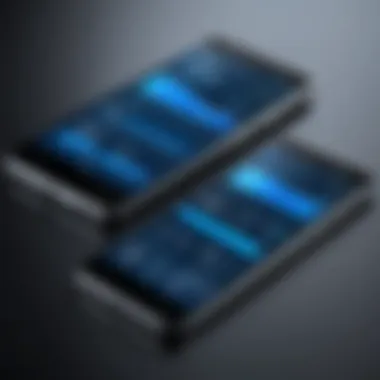The Evolution of Intel in the Smartphone Landscape


Intro
Intel's presence in the smartphone landscape has been a subject of fascination for many. Over the years, the company has ventured into mobile technology, aiming to capitalize on the growing smartphone market. This evolution is marked by major innovations, strategic decisions, and a drive to produce competitive processors that could potentially reshape the industry. To understand Intel's impact on the smartphone market, we must explore its technological advancements and the challenges it faced.
The integration of Intel's technology within smartphones highlights a journey that spans over a decade. Despite initial successes, the outcomes of Intel's strategies have been mixed, leading to a complex narrative filled with lessons and implications for future mobile computing.
Features Overview
Intel has unveiled various smartphone processors incorporating unique technical specifications. These innovations aimed not only at improving performance but also at providing an edge against competitors like Qualcomm and MediaTek.
Key Specifications
Intel’s mobile processors have a diverse range of specifications. Their latest mobile chipsets, like the Atom series, focus on balancing power efficiency and performance.
- Architecture: Uses x86 architecture which is different from the ARM architecture prevalent in most smartphones.
- Performance Cores: Incorporates multi-core technology which enhances multitasking capabilities.
- Integrated Graphics: Features advanced integrated GPUs for better graphics performance.
- Energy Efficiency: Tailored for low power consumption to maximize device battery life.
Unique Selling Points
The unique elements of Intel's processors made them appealing to smartphone manufacturers and developers alike.
- Cross-platform Compatibility: The ability to support various operating systems like Android and Windows.
- Robust Performance: Delivers solid performance metrics often comparable to leading competitors.
- Innovative Integration: Excelled in integrating connectivity solutions ensuring smooth data and communication processes.
- Support for Advanced Features: Enabled functionalities like NFC, LTE, and in some cases, even 5G capability.
"Intel aimed to bridge the gap between mobile and personal computing, showcasing an ambition for a unified technology ecosystem."
Performance Analysis
The success of any chip in a smartphone hinges on how it performs in real-world scenarios. Benchmarking results provide crucial insights into this aspect.
Benchmarking Results
Intel's processors have undergone several benchmarking tests to assess their strengths and weaknesses. Common benchmarks include Geekbench and AnTuTu, where Intel chips often showed competitive performance but struggled in specific areas.
- Single-core Performance: Strong performance due to high clock speeds.
- Multithreading: Struggled slightly compared to ARM chips in heavily threaded tasks.
- Graphics Benchmarking: Graphics performance is notable, though often rated lower than specialized graphics chips from other manufacturers.
Real-world Scenarios
When placed in practical applications, Intel processors showcased both strengths and challenges. In terms of everyday use, here are some observations:
- App Responsiveness: Fast loading times for apps in daily use.
- Gaming Performance: Handles mobile gaming reasonably well, though limitations appear in graphic-intensive titles.
- Battery Life: Real-world tests showed mixed results, with some Intel-powered devices being less efficient compared to their ARM counterparts.
Intel’s venture into the smartphone market reflects a broader ambition to merge computing platforms, yet it also illustrates the challenges in an industry characterized by rapid innovation. This evolution indicates potential trajectories for both Intel and the smartphone landscape as technology continues to advance.
Preface to Intel and Smartphones
The connection between Intel and the smartphone industry represents a significant chapter in the evolution of mobile technology. Understanding this intersection provides valuable insights into how a major player in computing has sought to adapt and innovate within a rapidly changing landscape. The importance of this topic in the broader context of computing and mobile devices cannot be overstated.
This exploration will illuminate various facets of Intel's journey, emphasizing how it responded to the challenges posed by an increasingly competitive market. Notably, it will cover not only Intel's entry into mobile technology but also the architectural advancements that accompanied this foray. This section sets the stage for a deeper examination of Intel's contributions to smartphone performance and efficiency, offering a background necessary for understanding its influence on the industry.
Historical Context
Intel's history spans several decades, with its roots in the development of microprocessors. Initially focused on personal computers, Intel began realizing the potential of mobile computing in the 2000s. The proliferation of smartphones revolutionized the mobile experience and introduced new demands for processor performance and efficiency.


The transition from traditional computing to mobile devices marked a pivotal change for Intel. Competitors began to emerge, some specializing strictly in mobile processors. This forced Intel to rethink its strategy and explore avenues to integrate its technological strengths into the smartphone market.
Intel's Initial Foray into Mobile
In 2010, Intel unveiled its first smartphone processor, the Intel Atom Z2460. This marked its official entrance into a field dominated by established players like Qualcomm and ARM. The Atom processors aimed to provide power-efficient performance while supporting the growing demands of mobile applications. However, Intel's challenges were immediate. The existing market had established preferences for ARM-based processors, known for their efficiency and compatibility.
Intel's strategy focused on leveraging its existing silicon manufacturing capabilities. This approach allowed the company to produce higher-performing chips while aiming to reduce power consumption. Despite the initial promise, Intel faced significant hurdles, predominantly in software support. Many major applications had been developed for ARM architecture, limiting the adoption of Intel-based smartphones. This disparity established a challenging landscape for Intel to navigate as it sought to carve out a niche for itself in a competitive environment.
Overview of Intel's Mobile Processors
The rise of smartphones has reshaped the tech industry, making mobile processors a crucial aspect of device performance. The significance of Intel's mobile processors lies not only in their technical specifications but also in their influence on user experience and competitive dynamics in the market. This section aims to clarify the architecture, technology, and comparative position of Intel's offerings within the wider smartphone landscape.
Architecture and Technology
Intel's mobile processors are built on a unique architecture designed to optimize both performance and efficiency. These processors, such as the Atom series, focus on achieving a delicate balance between high processing power and low power consumption. Their key features include:
- Low Power Consumption: Essential for extending battery life in smartphones.
- Multicore Design: Allows for better multitasking and smooth operation of applications.
- Integration of Graphics: Intel's processors often include integrated graphics units, helping to manage rendering without needing additional chips.
The impact of this architecture is evident in various applications, particularly in gaming and high-definition media consumption. Intel's investment in fabrication technologies, including a shift from 32nm to more advanced nodes, has further enhanced the processing capabilities of their mobile chips. This focus on innovation showcases Intel's commitment to remaining competitive in a fast-evolving marketplace.
Comparison with Competitors
In an industry dominated by Qualcomm and ARM-based processors, Intel's position has frequently been scrutinized. Yet, the comparative analysis reveals both strengths and weaknesses. Critical aspects to consider include:
- Performance: Intel processors are known for high computational power, often outperforming their competitors in certain benchmarks. The x86 architecture enables robust performance in demanding applications.
- Market Reach: While Qualcomm Snapdragon processors have gained a stronghold, particularly in high-end and mid-range devices, Intel's mobile processors have seen limited adoption among major smartphone brands.
- Versatility: Intel’s architecture supports a broad array of operating systems, giving it an edge in various niches, such as tablets and convertible devices. This flexibility allows manufacturers more choices in design and functionality.
However, Intel has faced challenges, particularly in terms of market share compared to competitors like Qualcomm, which has effectively optimized its chips for mobile communication standards and battery efficiency. The ongoing evolution of these sectors remains crucial for Intel's strategy moving forward.
Key Intel Smartphone Models
Intel's entry into the smartphone market marked a significant chapter in its history. The advent of smartphones brought about an exponential growth in mobile computing, and Intel sought to stake its claim within this fast-evolving landscape. The key models developed by Intel reflect both its ambitions and challenges in a field dominated by long-established players.
Intel Inside: Case Studies
Intel aimed to brand itself as a relevant player in smartphones through strategic partnerships and innovative products. Notable examples include the Lenovo K900 and Asus Zenfone.
The Lenovo K900 was particularly innovative. It featured a dual-core Intel Atom Z2580 processor operating at 2 GHz, a 5.5-inch display, and an impressive 13 MP camera. Its performance was praised for responsiveness, especially in handling multitasking. However, despite these strengths, it struggled to compete in markets where Qualcomm's Snapdragon series dominated, primarily due to brand allegiance and marketing efforts from competitors.
The Asus Zenfone, on the other hand, represented Intel's diversification strategy. It aimed to cater to a broader user base with various models presenting different specifications. The Zenfone 5 was a mid-range device powered by an Intel Atom processor, providing a balance between performance and cost. This model was better received due to Asus’s reputation in the hardware business and its understanding of consumer needs in varying price brackets.
Successes and Setbacks
The journey of Intel in smartphones was characterized by both successes and unforeseen setbacks.
On the one hand, Intel made a mark with advancements in processing power and energy efficiency. Its mobile processors introduced technologies like hyper-threading, enhancing performance without significant power draw. This was a crucial consideration as users demanded longer battery life alongside robust performance.
On the other hand, Intel faced market acceptance issues. The transition from traditional PCs to mobile devices required not only technological innovation but also adept marketing strategies. Many users were entrenched in ecosystems built around ARM-based processors, making it difficult for Intel to persuade them to switch. Additionally, the fast pace of mobile technology changes meant Intel's products quickly became outdated.
Impact of Intel's Technology on Performance
Intel's role in the smartphone landscape is significant, particularly when assessing its technology's impact on performance. Intel's processors have had to meet demanding requirements, balancing processing power, energy efficiency, and thermal management. These factors are crucial for delivering a smooth user experience in smartphones, where performance expectations continue to rise.


One of the main benefits of Intel's technology is its ability to manage intensive workloads. The company's focus on high-performance architectures means that it can deliver powerful processors capable of handling everything from basic tasks like web browsing to more intensive applications such as gaming or augmented reality. The attention to detail in designing processors ensures that users can experience seamless multitasking.
Furthermore, Intel has consistently pushed the boundaries regarding performance benchmarks. The testing of its processors often involves rigorous assessments against competing products. The results of these benchmarks provide valuable insight into how well Intel's processors operate across various tasks and conditions. With every iteration of their processors, Intel strives to improve not only raw performance but also real-world usability.
"A processor is not just about speed; it's about how well it handles demanding applications while maintaining efficiency."
Benchmarks and Testing
Benchmarks serve as a standard for evaluating the performance of Intel's mobile processors relative to competitors. Professional reviewers and tech enthusiasts often turn to these tests to understand how these processors perform under various conditions.
Several metrics are typically measured:
- CPU performance: This includes single-core and multi-core benchmarks, showing how well the processor can execute tasks.
- Graphics performance: With mobile gaming on the rise, assessing GPU capabilities is vital for understanding user experience.
- Thermal performance: Keeping temperatures in check during demanding tasks can affect performance sustainability.
Intel often utilizes tools such as Geekbench, 3DMark, and others to gather comprehensive performance data. Each new processor generation brings enhancements, and this data helps consumers make informed choices. Testing also extends beyond raw numbers; it includes real-world usage scenarios that demonstrate how processors perform over time under typical user conditions.
Battery Life and Efficiency
The balance between performance and battery life is a cornerstone of modern smartphone design. Intel's innovations in mobile processors have aimed to improve battery life without sacrificing performance. The efficiency of a processor directly influences how long a device can operate before needing a recharge. Intel's architecture often prioritizes energy-saving features, adjusting performance dynamically based on workload demands.
Keypoints in this area include:
- Dynamic Frequency Scaling: Processors can adjust their frequency and voltage levels based on the current task, which helps save battery when the demand is low.
- Low-Power States: Intel utilizes various states where the processor can enter to conserve energy without shutting down entirely.
- Integrated Graphics: By using integrated graphics solutions, Intel reduces the number of discrete components, resulting in better power management.
As energy efficiency becomes increasingly crucial, Intel's strides in this area reflect its commitment to enhancing the end-user experience. Users demand longer battery life, especially with the multitude of applications constantly running in the background. Intel’s technological advancements serve this need without compromising the processing abilities required for high-performance tasks.
Market Dynamics and Intel's Position
The interplay between market dynamics and Intel's position in the smartphone landscape is critical for understanding the company's trajectory and ongoing relevance. Market dynamics refer to the various forces that influence the supply, demand, and competitive environment of the smartphone industry. Intel's ability to navigate these dynamics has had significant implications on its successes and failures in mobile technology.
Intel entered the smartphone market primarily as a chipset provider, introducing products designed to enhance processing power and efficiency. The evolution of this market, driven by shifts in consumer preferences, technological advancements, and competitive pressures, dictated Intel's approach. Understanding these dynamics is essential for appreciating the context within which Intel operated.
The Smartphone Industry Landscape
The smartphone industry is characterized by rapid technological innovation and highly competitive players. From giants like Apple and Samsung to emerging brands such as Xiaomi and OnePlus, the landscape requires constant adaptation. Industry growth is driven by consumer demand for sophisticated features, performance, and user experience, making it a hotspot for technological developments.
- Consumer Preferences: With an ever-increasing need for smartphones that blend performance with energy efficiency, Intel had to adapt its technology to meet these expectations.
- Competitive Pressures: The aggressive push from ARM-based processors, which dominated the market with efficiency and power, posed challenges for Intel.
- Technology Trends: The rise of Artificial Intelligence, 5G connectivity, and IoT integration reshaped the demand for mobile processors, influencing Intel's focus and product design.
Intel's goal was clear: to capture a sizable portion of the smartphone market shared by established competitors. To do so, it introduced products emphasizing powerful computing capabilities while simultaneously addressing battery life concerns.
Intel's Market Share Trends
Intel's market share in the smartphone segment has experienced significant fluctuations over the years. Initially, Intel's entry into the mobile processor market was met with enthusiasm, especially with the introduction of the Intel Atom series. However, maintaining this share has proven challenging for several reasons:
- Late Entry: Intel's foray into smartphones occurred after many competitors had already established strongholds in the market.
- Product Performance: Although Intel's processors offered impressive features, they sometimes lagged behind ARM counterparts in energy efficiency, a key area for smartphones.
- Strategic Partnerships: The lack of partnerships with major smartphone manufacturers limited Intel's visibility and market penetration. Competing processors had better ecosystem compatibility.
Despite these challenges, Intel adapted its strategy over time. By investing in research and development, the company aimed to innovate its product line to meet future consumer demand. Yet, market data has shown a persistent decline in Intel's share as competitors further refined their offerings.
"Navigating market dynamics is essential for growth. Intel’s experience reflects the importance of agility in the fast-evolving smartphone tech sector."
In summary, the market dynamics surrounding Intel's position in the smartphone landscape illustrate the complexities and challenges inherent in such an intricate industry. Intel's journey serves as a lesson on how external factors significantly shape the technology landscape.


Challenges Faced by Intel
The realm of mobile technology presents multifaceted challenges, and Intel encountered its share in this landscape. Understanding these challenges is crucial for discerning the trajectory of Intel's growth and innovation in the smartphone sector. These obstacles inform the reader about both the internal struggles within the company and external market dynamics that shaped its strategic choices. It highlights the resilience required within a competitive environment and offers lessons on adaptability and foresight in technology development.
Technical Hurdles
Intel's pursuit of innovation in mobile processors was met with significant technical hurdles. The transition from desktop to mobile required a stringent focus on power efficiency without compromising performance. Unlike traditional computing environments, smartphones demand processors that balance computation with limited energy resources, primarily due to battery constraints. The development of the Atom series, for instance, highlighted the difficulty of designing chips that could deliver satisfactory performance while minimizing heat generation and maximizing battery life.
Additionally, Intel faced challenges in integrating its architecture with existing mobile operating systems, such as Android. This integration was not just a matter of device compatibility but also involved enhancing performance capabilities to match or exceed competitors like Qualcomm. The struggle to establish a foothold in a market consolidated by established players reflected in Intel's late entry into the mobile game, leading to delays in the rollout of products that did not meet consumers' expectations.
"The shift to mobile was not merely a trend for Intel; it was an urgent call to revamp and adapt its recognized architectures to the constraints of the mobile market."
Strategic Decisions and Consequences
The strategic decisions taken by Intel molded the company’s path in the mobile landscape, but these were not free from consequences. Intel opted to invest heavily in its mobile division, believing it could leverage its existing technologies to secure a strong market position. However, this conviction resulted in substantial investments that did not yield proportional returns. The move to acquire smaller tech firms aiming to boost mobile capabilities also raised questions about synergy and integration within the corporation.
As the smartphone market evolved, Intel struggled to pivot its strategy adequately. Competing with ARM architecture, which dominated mobile processing with its energy-efficient designs, proved to be a herculean task. Instead of quick adaptations, Intel often appeared to linger in an old mindset rooted in its success within the PC market. This hesitation delayed the development of competitive products, ultimately leading to lost market share and credibility.
Moreover, by overestimating the demand for its products and underestimating competitors' capacity for innovation, Intel encountered financial setbacks. These choices illustrated that even industry giants face repercussions when they falter in foresight and are unable to pivot effectively in response to dynamic market conditions.
Future of Intel in Mobile Technology
As we look ahead at the future of Intel within the mobile technology sector, it is essential to realize the interplay between advancements in processing technologies and user demands. Intel has traditionally been associated with personal computers, but its ability to innovate in mobile technology remains a vital topic in understanding the company's landscape.
Intel's efforts to develop mobile processors play a key role in shaping the future. Optimal performance, energy efficiency, and the ability to support advanced features are crucial for any successful mobile device today. With the continuous growth of mobile computing, Intel’s focus should encompass not only hardware development but also software integration and compatibility across various platforms.
Predictions and Trends
The smartphone market evolves rapidly, presenting new opportunities and challenges for Intel. Here are a few predictions about Intel's role in mobile technology:
- Increased Integration: Expect Intel to pursue tighter integration between hardware and software. This would lead to more efficient power management and improved application performance, essential for modern smartphones.
- Growth in 5G and Beyond: As 5G technology becomes standard, the need for processors that can efficiently handle the demands of high-speed data transfer will be paramount. Intel's expertise in network solutions may provide an edge in this arena.
- Focus on AI: Artificial intelligence is becoming essential in smartphones. Intel's dedication towards building processors that can handle AI tasks, such as image processing and voice recognition, will likely become a competitive advantage.
In the coming years, Intel's engagement in mobile technology will be informed by these trends and more. Understanding these elements can provide insights into how Intel may evolve its strategies.
Innovations on the Horizon
Intel is also known for its powerful innovations. Here are some anticipated advancements that could shape Intel's future in mobile technology:
- New Processor Architectures: We expect Intel to unveil new architectures designed specifically for mobile devices. These designs should focus on maximizing performance while maintaining low power consumption.
- Enhanced Security Features: As cyber threats increase, Intel's emphasis on security in its mobile processors is likely to rise. Innovations in this area may include hardware-based security solutions that can protect user data more effectively.
- Expansion of IoT Capabilities: With the increasing interconnectivity of devices, integrating mobile processors with Internet of Things (IoT) capabilities can provide numerous benefits. Intel may explore strategic collaborations to drive this forward.
Intel's capacity to adapt its technology to meet the evolving demands of mobile computing will be critical for its success in the smartphone landscape.
As Intel continues to innovate, it will need to remain aware of industry trends and user demands while developing products that offer not only performance but also sustainability. By doing so, Intel can secure its position in the competitive mobile technology space.
Ending and Final Thoughts
Understanding the repercussions of Intel's journey provides essential insights for IT professionals and tech enthusiasts alike. The strategic decisions made by Intel throughout its history influence how companies develop their mobile devices, design processors, and manage market competition.
Recapitulating Key Points
- History and Context: Intel’s foray into mobile technology began with various initiatives that sought to extend its dominance in computing to smartphones.
- Mobile Processors: The performance and architecture of Intel's processors shaped their position against competitors like Qualcomm and Apple.
- Market Dynamics: Intel's attempts to gain market share involved strategic partnerships and product launches, but market realities often diverged from expectations.
- Impact on Future Technologies: The changing landscape of mobile technology necessitates ongoing innovation. Intel's insights help predict future trends in mobile computing as influenced by advancements in semiconductor technology.
The Ongoing Legacy of Intel
Intel’s legacy in the smartphone industry is multifaceted. While it may not have secured a leading position, its impact on mobile technology can still be seen. The lessons learned from Intel’s experiences offer valuable perspectives for other companies aiming to innovate in this space.
The emphasis on power efficiency, multi-core architectures, and integrated graphics influences current smartphone designs. Furthermore, Intel's research and development efforts contribute to future technology trends that extend beyond smartphones into areas such as IoT and AI.



